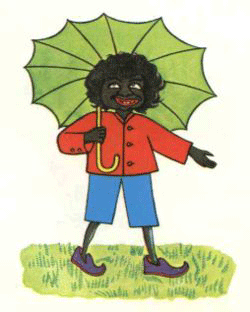 The infamous “Black Sambo” image.
The infamous “Black Sambo” image.
Observations on the Baboons in the Garden of the “Bostan” Restaurant (Part Two)
[Note: These observations were first published in 1991 in Yemen Update and are archived online. The “Boston” has long since disappeared, but memories live on. For Part One, click here.]
Let me introduce you to the other guests besides myself, Flo and Eddy. At the table in front of me sat two Egyptian men who were soon joined by two Frenchmen. There was a rather abrupt shift from Cairene Arabic to French (or at least a form of French). What struck me was not the Egyptian or the French dialects, but the visual message on the back of a t-shirt worn by one of the French diners. This might have been purchased anywhere, of course, since all these designs are mumbo-jumbled internationally. First of all the color of the t-shirt was that of over-ripe banana pulp (it really was). Emblazoned on the back were four figures, each of them a replica of the racist “Black Sambo” image of Blacks in America during the “Amos ‘n Andy” era. One of these caricatures was boxing, another surfing, and so on. I suppose it was supposed to communicate nothing significant and for the most part it did here in Yemen. But I was somewhat appalled and was tempted to ask the fellow, whose back was a billboard for my face, to take off his shirt and wear it backwards (assuming only the over-ripe banana exuded on the front).
A Yemeni child, perhaps about three or four years old, walked by in a far more palatable t-shirt. It simply said “Gator Beach” and showed a Florida style beach with palm trees and a sailboat. This I could take with a smile, even though I remember reading in one of the super-market tabloids that killer gators were escaping the Everglades and would soon be the death of us all.
The t-shirt billboard is a social custom that to my knowledge has not been given serious attention. Do people really want to advertize the products named on the shirt or communicate the gross messages flashed on front or back? There is a wealth of t-shirt types in Sanaa. The one that really struck me this time was made in Indonesia. It shows a shark named “Mr. Mako” and peddles a fictitious (I hope) “Shark Bite Beer”. Of course this beer has a “smooth predatory taste”. (The designer label, by the way, shows an American Indian head in full headdress.) One of the t-shirts making the rounds in Sanaa shows Saddam and reads “Allahu akbar,” surely a collector’s item for the wayward tourist if ever there was one.
The way people dress always amazes me. Most foreigners in Yemen try to respect local custom, expecially those who are resident for a period of time. But it seems that a trip on Friday afternoon to the Bostan allows for a bit of relaxation. The skirts on the European women are shorter and the men sport t-shirts. What intrigues me is how it is virtually impossible to identify the nationality of children from the clothing. There may be a Yemeni family with the women in sharshaf, but the children dress like children anywhere, mostly t-shirts and shorts. Yet there will probably come a point when the clothes will mean something and be chosen for a more blatantly social purpose. But if the children can mix and play as one, will they not want to do so when they grow up?
The Bostan highlights a number of anomalies in modern Yemen, the mixing of traditions, the merging of the old with the new. I saw a family with a Yemeni man married to a European wife. There are the lonely Lebanese and Syrian workers, the foreign consultants escaping from claustrophobic hotels, a few struggling students. The melting pot which this Lebanese restaurant hosts goes beyond the children’s swings, t-shirts, and caged baboons. One of the most poignant metaphors of change is the presence of rows of Mousy non-alcoholic beer in a cooler near the garden area. It looks like a regular beer can, but of course the liquid inside does not taste like it. Now, to my mind the taste of non-alcoholic can beer is a Madison Avenue nightmare. I have never actually met anyone who admits to drinking it, unless by mistake or just for an initial trial. It’s presence here is ultimately a joke, because a Muslim would hardly be tempted to try it (even if it is non-alcoholic) and any true beer drinker would rather go without. Could these be the same cans I saw a year ago, or even seven years ago at the “Candles” restaurant? What is the half-life of non-alcoholic beer, anyway?
Back to Flo and Eddy. As I finished the last of my coffee (Do you ask for Arabic or Turkish coffee in Yemen?), I turned the cup over as though my fortune could be read from it. It no doubt annoys the waiters, but I like looking for the ridges and guessing if I have a long journey ahead of me. Of course, it never works to tell your own future. I left the Bostan more concerned about the future of Flo and Eddy. No doubt there will be two baboons in the cage when I return to Sanaa the next time, but will I recognize Flo (still wondering about that odd unedible spaghetti) and Eddy or whatever else other travelers might name them? If you happen to get to Sanaa before I do, please do me a favor. Drop by the Bostan for lunch and say hello to Flo and Eddy. Also, please let me know if any of the lightbulbs have sprouted yet.
Daniel Martin Varisco